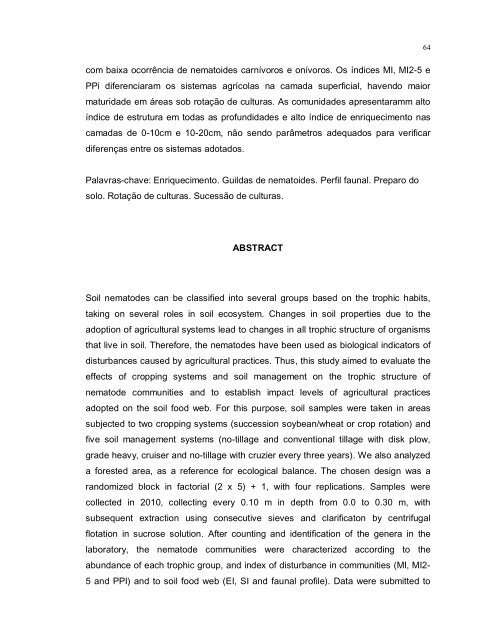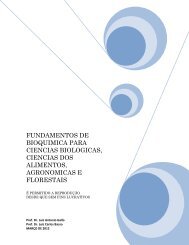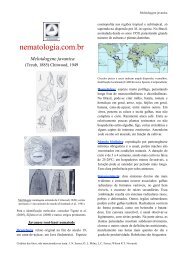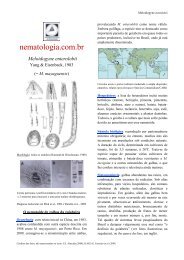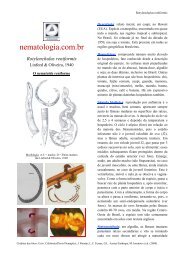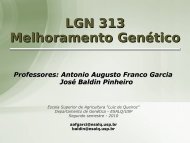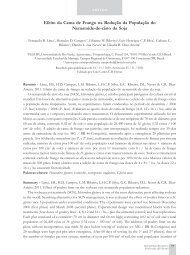diversidade de nematoides em sistemas de culturas e ... - Index of
diversidade de nematoides em sistemas de culturas e ... - Index of
diversidade de nematoides em sistemas de culturas e ... - Index of
Create successful ePaper yourself
Turn your PDF publications into a flip-book with our unique Google optimized e-Paper software.
64com baixa ocorrência <strong>de</strong> n<strong>em</strong>atoi<strong>de</strong>s carnívoros e onívoros. Os índices MI, MI2-5 ePPi diferenciaram os sist<strong>em</strong>as agrícolas na camada superficial, havendo maiormaturida<strong>de</strong> <strong>em</strong> áreas sob rotação <strong>de</strong> <strong>culturas</strong>. As comunida<strong>de</strong>s apresentaramm altoíndice <strong>de</strong> estrutura <strong>em</strong> todas as pr<strong>of</strong>undida<strong>de</strong>s e alto índice <strong>de</strong> enriquecimento nascamadas <strong>de</strong> 0-10cm e 10-20cm, não sendo parâmetros a<strong>de</strong>quados para verificardiferenças entre os sist<strong>em</strong>as adotados.Palavras-chave: Enriquecimento. Guildas <strong>de</strong> n<strong>em</strong>atoi<strong>de</strong>s. Perfil faunal. Preparo dosolo. Rotação <strong>de</strong> <strong>culturas</strong>. Sucessão <strong>de</strong> <strong>culturas</strong>.ABSTRACTSoil n<strong>em</strong>ato<strong>de</strong>s can be classified into several groups based on the trophic habits,taking on several roles in soil ecosyst<strong>em</strong>. Changes in soil properties due to theadoption <strong>of</strong> agricultural syst<strong>em</strong>s lead to changes in all trophic structure <strong>of</strong> organismsthat live in soil. Therefore, the n<strong>em</strong>ato<strong>de</strong>s have been used as biological indicators <strong>of</strong>disturbances caused by agricultural practices. Thus, this study aimed to evaluate theeffects <strong>of</strong> cropping syst<strong>em</strong>s and soil manag<strong>em</strong>ent on the trophic structure <strong>of</strong>n<strong>em</strong>ato<strong>de</strong> communities and to establish impact levels <strong>of</strong> agricultural practicesadopted on the soil food web. For this purpose, soil samples were taken in areassubjected to two cropping syst<strong>em</strong>s (succession soybean/wheat or crop rotation) andfive soil manag<strong>em</strong>ent syst<strong>em</strong>s (no-tillage and conventional tillage with disk plow,gra<strong>de</strong> heavy, cruiser and no-tillage with cruzier every three years). We also analyzeda forested area, as a reference for ecological balance. The chosen <strong>de</strong>sign was arandomized block in factorial (2 x 5) + 1, with four replications. Samples werecollected in 2010, collecting every 0.10 m in <strong>de</strong>pth from 0.0 to 0.30 m, withsubsequent extraction using consecutive sieves and clarificaton by centrifugalflotation in sucrose solution. After counting and i<strong>de</strong>ntification <strong>of</strong> the genera in thelaboratory, the n<strong>em</strong>ato<strong>de</strong> communities were characterized according to theabundance <strong>of</strong> each trophic group, and in<strong>de</strong>x <strong>of</strong> disturbance in communities (MI, MI2-5 and PPI) and to soil food web (EI, SI and faunal pr<strong>of</strong>ile). Data were submitted to


